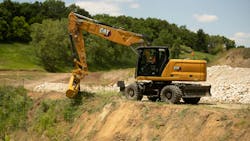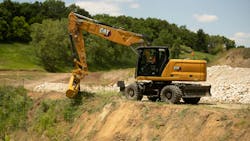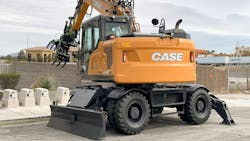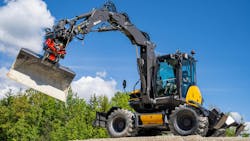Although wheeled excavators have yet to proliferate in North America the way they have in Europe, manufacturers have been adding models here as well as technology, and the already-versatile units are receiving a boost from tiltrotators.
Designed for work on and off road, but not on viscous, loose surfaces, wheeled excavators are best known for their mobility—the ability to travel quickly between jobs without the use of a trailer. They can also work near buildings and on narrow streets (hence the popularity in Europe), and many can work within one lane of traffic.
The ability to use various buckets allows the excavators to excavate soil, sand, and other materials. They can also trench and perform rolling ditch work and load a variety of trucks and dumpers.
Hammers, grabs, forks, thumbs, plate compactors, boom-mounted mowers, and more, serve many different applications.
What’s right for you?
European dealer Avesco Cat has a solid primer on selecting a wheeled excavator.
First, decide on the scope and nature of the work, and consider the area in which it is to be carried out. For example, the tracked mini excavator is ideal for small tasks in the private sector, for minor construction work and for laying pipe, electric, or communication cables. Larger models on tracks are recommended for tasks in large suburban sites, quarries, and mining.
For construction work in the city, a wheeled excavator can be the best choice. It can travel public roads and doesn’t require special transport arrangements for short distances. Loading a heavy crawler excavator and transporting the equipment to its destination and then unloading it not only requires special transport, but also incurs higher costs.
In addition to excavating or loading into trucks, the right choice of wheeled excavator will allow its use for leveling the site before the foundation work starts, as a crane for unloading or loading building materials, and for other tasks such as the placement of concrete blocks or Jersey barriers.
Among the main criteria for choosing an excavator are its weight and power.
Larger excavators should be bought for long-term, permanent work. A machine of this size and power will pay off the purchase and maintenance costs with its efficient performance, Avesco says.
If the workload is not sufficient, the excavator will often stay idle. For more cost-effective use of the machine, it would be better to buy a lower-powered excavator.
However, choosing a model that is too small may not meet the needs of the job at hand. On the other hand, choosing a model that is too large can be too complicated and, more importantly, too expensive.
To make the right choice, analyze the issues relating to the nature and amount of work to be done.
This will also determine the excavator’s capacity requirements, which is why both the lifting capacity and bucket size are important.
If the excavator is loading dump trucks, the bucket should have the capacity and size to load the truck body in four to six loading cycles. However, in this case, we do not know the power required for the excavator. To solve the issue of excavator performance at the expense of the bucket size will not only overload the hydraulic system, but excessive boom loads can cause rapid wear and breakage.
In addition, without the right balance between the bucket, the boom, and capacity, the stability of the excavator is compromised, where a fully extended boom and a full bucket can make the machine unstable and cause it to tip.
Therefore, not only must the size of the bucket and the power of the excavator be selected, but also the permissible combination of bucket and boom. Of course, a larger bucket can pick more soil at a time, but this combination also has corresponding power requirements.
A Twist on Productivity
The growing use of tiltrotators in North America seems to be tailor made for the already versatile wheeled excavator category.
The three major European tiltrotator manufacturers working for a foothold here are Engcon, Steelwrist, and Rototilt. A number of OEMs have already forged partnerships with one of these manufacturers.
Tiltrotators allow the use of excavator attachments at a 45-degree angle and with 360-degree rotation. This flexibility means the operator does not have to move and reposition the excavator as often. Work can be performed closer to objects. Managers can realize less wear and tear on units, and perhaps even a fuel savings.
“A tiltrotator makes it easier for you to work with an excavator, thanks to the increased flexibility of the work tool’s movements,” says Rototilt product manager Sven-Roger Ekström. “It enables you to adjust the angle and rotation of the work tool, which in turn makes it easier to carry out tasks with fewer machine movements. This saves fuel, but it has even more advantages in the long run.
“We call this the tiltrotator effect,” Ekström says. “We have always known that there is a big difference between working with and without a tiltrotator. Not only do you need to use fewer machines, but you can also carry out the task at hand with fewer movements and changes of position. This saves both fuel and time, as well as reducing the impact on the ground where you are working.”
Newer developments
Wheeled excavators as a category do not see the frequency of model changes of their tracked brethren, but there are some notable developments.
Develon recently launched a mini wheeled excavator, the DX100W-7, meant to fill a gap between its mini excavators and larger wheeled excavators. The 25,221-pound excavator has a maximum digging depth of 13 feet 11 inches, maximum dumping height of 20 feet 6 inches, and bucket breakout force of 13,173 pounds.
The DX100W-7 excavator is powered by a Develon D34 100.6-horsepower engine, with speeds up to 24 mph. The reinforced articulated boom features an additional pivot point, which enhances the working range, lifting capacity, and digging force, according to the company.
Since the last time Construction Equipment looked at the category, Caterpillar refreshed the heavy end of their line with the M319 and M320 wheeled units.
See the Top 10 Wheeled Excavators
The larger unit, the M320, was given 9% more swing torque than its F Series predecessor and the hydraulic system was improved to increase efficiency when working with the company’s attachments.
A Cat C4.4 engine has efficiency-minded standard features such as one-touch low idle with automatic engine speed control, auto engine idle shutdown, and on-demand cooling fans.
The M320 also has a dedicated swing pump for multitasking. An advanced hydraulic system is designed to automatically balance power and efficiency to give operators more control in precise working environments. A heavy lift mode feature boosts lifting capacity.
Right-side and rearview cameras are standard, and an optional 360-degree visibility system combines input from multiple cameras around the machine to enhance the operator’s view.
Takeuchi has brought its first ever wheeled excavator model to North America.
The TB395W features two four-wheel steering modes: 4WS (all-wheel steering) and 4WSC (crab steering). A wide-range, longer stick arm allows for greater clearance between the bucket and dozer blade due to the arm mount position. As a result, operators of the TB395W can pull the bucket all the way to the dozer blade, which helps when working in narrow spaces or moving an obstacle out of the way.
Auto Cruise enables operators to set and adjust their travel speeds by pressing a button or operating a toggle switch (on an optional, multifunction grip). Auto Cruise is ideal for attachments that require a consistent, repeatable travel speed, such as a mulcher, mower, or trencher.
Case Construction Equipment has also brought wheeled models to the North American market, including the WX175E SR. It is designed to reach tight urban job sites at speeds up to 25 mph.
Operating weight is just over 44,000 pounds, and rated power is 173 horsepower at 2,200 rpm. A load-sensing hydraulic system allows for multifunctional operation and precise machine movements, and proportional auxiliary hydraulics enable smooth, precise control of attachments.
An optional Fine Swing control increases precision with less material spillage, and Power Boost provides an instant increase in power when needed.
About the Author
Frank Raczon
Raczon’s writing career spans nearly 25 years, including magazine publishing and public relations work with some of the industry’s major equipment manufacturers. He has won numerous awards in his career, including nods from the Construction Writers Association, the Association of Equipment Manufacturers, and BtoB magazine. He is responsible for the magazine's Buying Files.




